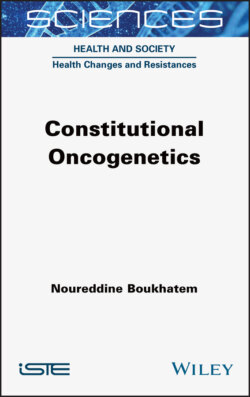Читать книгу Constitutional Oncogenetics - Noureddine Boukhatem - Страница 33
1.7. Penetrance
ОглавлениеDEFINITION.– Penetrance refers to the likelihood that a clinical condition will occur when a particular genotype is present. A condition is said to have incomplete penetrance when some individuals carrying the pathogenic variant express the associated trait while others do not. It is expressed as the percentage of cases that express the associated phenotype among all carriers of the pathogenic variant.
Figure 1.3. Incomplete penetrance. Individual II3 is an obligatory carrier of the genetic anomaly (their father is sick, they have a sick sister and son as well), but they express a normal phenotype
Carriers of deleterious BRCA1/2 mutations have a cumulative breast cancer risk of 50–85% and an ovarian cancer risk of 15–60% at age 70.
The increased risk of contralateral breast cancer (CBC) in carriers of pathogenic BRCA1 and BRCA2 variants has been confirmed in several large studies. Estimates of the 10-year cumulative risk of CBC in BRCA1/2 carriers range from 18% to 34% for BRCA1 pathogenic variants and 11% to 29% for BRCA2 pathogenic variants.
It is also estimated that the risk of bilateral breast cancer at age 60 is as high as 64% in carriers of BRCA1 mutations diagnosed with breast cancer.
CBC risk was also inversely correlated with age in some studies, with the highest risks observed in women whose first case of breast cancer occurred before the age of 40.
The risk of ovarian cancer is estimated to be 39% for carriers of pathogenic BRCA1 variants and 11–17% for carriers of pathogenic BRCA2 variants.
PALB2 mutations have been shown to confer an absolute breast cancer risk of 33–58% at age 70.
Mutations leading to the production of truncated CHEK2 proteins have been associated with a clinically significant risk of breast cancer in mutation carriers without an affected first- or second-degree relative (20%), and this risk may be as high as 44% in mutation carriers with an affected first- or second-degree relative.
The CHEK2 mutation associated with a family history of breast cancer results in a 28–37% lifetime risk of breast carcinoma, but does not increase the risk of ovarian cancer.
Inactivating variants of BRIP1 are associated with an increased risk of breast cancer. The monoallelic mutations in BRIP1 confer a relative risk of 2.0 for the development of breast cancer. However, there is incomplete segregation of the pathogenic variants BRIP1 and CHEK2 with breast cancer.
Although the data for RAD51C are conflicting, among these data there is substantial evidence of a modest association between germline variants of RAD51C and breast and ovarian cancers.
Note.– The genes widely recognized as conferring a risk of breast or ovarian cancer are distributed as follows:
– breast cancer: BRCA1, BRCA2, PALB2, PTEN, STK11, TP53;
– ovarian cancer: BRCA1, BRCA2, MLH1, MSH2, MSH6, PMS2, RAD51C, RAD51D.
For breast cancer:
– it has been agreed that ATM and CHEK2 confer a moderately increased risk of breast cancer, but concerns about the interpretation of the results of these genes led to a recommendation that only truncated variants be reported, in addition to ATM c.7217T > G (p. Val2424Gly ), which is recognized as conferring an increased risk of breast cancer;
– CDH1 has also been shown to confer a risk of breast cancer, but only in the specific case of lobular breast cancer;
– insufficient evidence has been found for a significant risk of breast cancer associated with NBN, BRIP1 or BARD1.
For ovarian cancer, it has been accepted that BRIP1 confers a sufficient risk of ovarian cancer, so a prophylactic bilateral adnexectomy should be considered.
